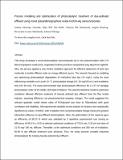Process modeling and optimization of photocatalytic treatment of dye-polluted effluent using novel polyaniline/graphene oxide-Fe3O4-Ag nanocomposites

View/
Date
2024-12-01Author
Oyetade, Joshua
Hulle, Stijn
Hammond, Vanessa
Boateng, Angela
Machunda, Revocatus
Hilonga, Askwar
Metadata
Show full item recordAbstract
This study developed a novel photocatalytic nanocomposite via in situ polymerization with 3 % blend of graphene oxide (GO), magnetite (Fe3O4) and silver nanoparticle (Ag-Nps) from AgNO3. Also, the process applied a new Fenton mediative approach for efficient abatement of toxic dye molecules in textile effluent under an energy-efficient source. The research focused on modeling and optimizing photocatalytic degradation of methylene blue dye (10 mg/L), using the most influencing variables such as pH (3–7), photocatalyst dosage (10–30 mg/100 mL) and irradiation time (20–90 min). The study demonstrated high photocatalytic efficiency for a 2.27 eV bandgap photocatalyst under 18 W visible LED light irradiation. The selected statistical model at optimized conditions allowed effective treatment of heavily polluted dye effluent from the flax textile industry, assessing efficiency via physicochemical property changes. The result suggested the selected quadratic model whose value of R2Adjusted was close to R2predicted with good correlation and reliability. All experimental variables via the analysis of variance were statistically significant (p-values <0.0001), with irradiation time and photocatalyst dosage having the greatest interactive influence on dye-effluent photocatalysis. Also, the optimization of the response gave an efficiency of 96.10 % which was validated by 5 repetitive experimental runs having an efficiency of 95.8 % ± 0.05 at selected optimized conditions of 79.24 min, 5.25 pH and dose of 21.76 mg/ 100 mL effluent. Thereafter, at the optimized conditions and 360 min of irradiation, 95.99 % dye effluent treatment were achieved. Thus, the study presents versatile industrial photocatalysts for treating heavily polluted dye effluent.
URI
https://doi.org/10.1016/j.jwpe.2024.106548https://dspace.nm-aist.ac.tz/handle/20.500.12479/2894
